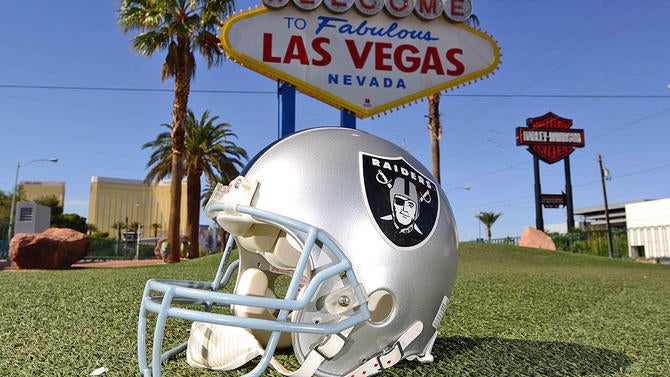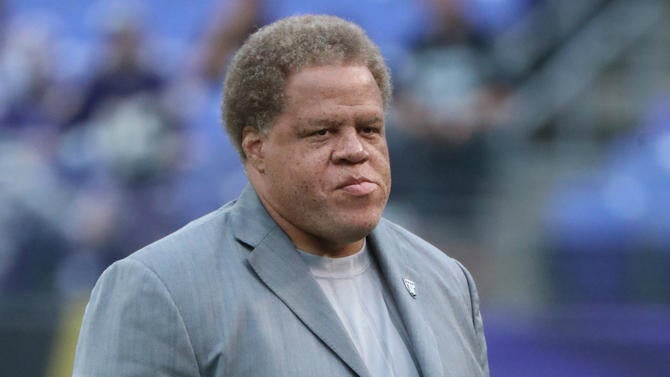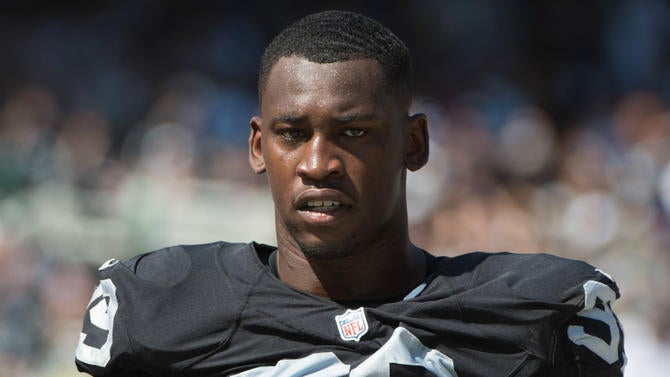The Raiders took a big step forward this season. Expectations increased as the season progressed, with the Raiders going from a trendy preseason playoff pick to legitimate Super Bowl contender by midseason.
Oakland's fortunes took a turn for the worse when Pro Bowl quarterback Derek Carr was sidelined for the season with a broken right fibula in a Week 16 Christmas Eve game against the Colts. Super Bowl hopes went out the window with Carr's injury. Losing the quarterback was a devastating blow that they couldn't overcome as the Raiders were eliminated from the playoffs in a 27-14 loss to the Texans in the wild-card round.
Overall, the 2016 season was a tremendous success for Oakland despite the abrupt ending. The Raiders reached the playoffs for the first time in 14 years, and, with 12 wins, posted their best win total since 2000.
A different set of challenges await the Raiders because of their newfound success. Here's a look at what's in store for Oakland during the offseason.
Relocation resolution
With the season completed, owner Mark Davis can focus his attention on gaining approval to move the franchise to Las Vegas. The Raiders are expected to file a relocation request in the coming weeks. Davis reportedly will present details of the Las Vegas plan to the league's finance and stadium committees at a Jan. 11 meeting in New York. A $1.9 billion stadium with $750 million of taxpayer funding already has the backing of the Nevada state legislature and Gov. Brian Sandoval.
NFL commissioner Roger Goodell has expressed a preference for the Raiders to remain in the larger, well-established Bay Area market. A viable stadium plan to keep Raiders in Northern California doesn't exist yet.

The Raiders must garner the support of three-fourths of the NFL's 32 owners in order to move. A vote is expected in March at the league owners' meeting in Phoenix. Even if relocation is approved, the stadium in Las Vegas wouldn't be ready to open until 2020.
High-priced contract extensions
The Raiders have been proactive in extending the contracts of core players well in advance of free agency. A substantial amount of effort will be devoted to maintaining this philosophy, since Carr and 2014 fifth-overall pick Khalil Mack are now eligible for new contracts.
Carr will be a higher priority because he is entering his contract year. Mack won't be in his contract year until 2018 since first-round picks are subject to a fifth-year option, which the Raiders will surely exercise for approximately $13.7 million.
Carr, who had an MVP-caliber season, is line for a deal that could eclipse Andrew Luck's five-year, $122.97 million offseason extension with the Colts. Luck reset the NFL pay scale with his deal that averages $24.594 million per year and contains $87 million in guarantees, of which $47 million was fully guaranteed at signing.
Mack has been everything the Raiders could have hoped for and more. He followed up a 2015 campaign where he became the first player in NFL history to earn first-team All-Pro honors at two different positions during the same season (defensive end and outside linebacker) with another first team All-Pro selection. He is a leading NFL Defensive Player of the Year candidate this season.

The Raiders are facing an extremely unusual situation because of Carr and Mack's success. It is rare for teams to have a quarterback on a lucrative contract while also having one of the league's highest paid non-quarterbacks. Among the seven highest paid non-quarterbacks by average yearly salary -- which are Von Miller (Broncos), Ndamukong Suh (Dolphins), Muhammad Wilkerson (Jets), Fletcher Cox (Eagles), Olivier Vernon (Giants), Justin Houston (Chiefs) and J.J. Watt (Texans) -- only the Giants have a quarterback (Eli Manning) making at least $20 million per year.
Mack appears destined to become the NFL's first non-quarterback to make $20 million per year with at least $75 million in guarantees. That is provided Rams defensive tackle Aaron Donald, who is also eligible for a new deal as a 2014 draftee, doesn't beat him to it. The Rams have a history of giving early extensions to their first-round picks. Donald's deal would serve as Mack's salary floor in this instance.
Gabe Jackson, a 2014 third-round pick, is also eligible for a new deal, which could get put on the back burner. He made a successful transition to right guard from left guard while accommodating free agent signee Kelechi Osemele, who Oakland made the NFL's highest-paid guard with a five-year, $58.5 million deal (worth up to $60 million through incentives) containing $25.4 million guaranteed.
In order to keep Jackson with the Silver and Black long-term, it will probably require the Raiders becoming one of the rare NFL teams with a heavy financial investment in guards, giving Jackson the going rate of $8 million per year and more than $20 million in guarantees for the second tier of salaries at the position. The Bears are currently the only team with the both members of the guard tandem having contracts average at least $7 million per year. Kyle Long and Josh Sitton are at $10 million per year and $7 million per year, respectively.
Salary cap and unique contract structure
The top 51 cap numbers on each team count toward the salary cap during the offseason. The Raiders have approximately $123 million in 2017 cap commitments with 54 players under contract, while $8 million of unused cap room is being carried over from the 2016 league year.
NFL teams were informed at a December league meeting that the 2017 salary cap is projected to be between $166 million and $170 million. These projections are consistent with the 8 percent annual growth of the salary cap in recent years.
Once you factor in not-likely-to-be-earned incentives that were achieved, tenders for restricted free agents and exclusive rights players with expiring contracts, and the proven performance escalator for eligible 2014 draft picks, Oakland should have approximately $45.5 million of 2017 cap space, assuming a $168 million salary cap.
At least half of Oakland's cap room will likely be devoted to Carr's extension because of general manager Reggie McKenzie's method of structuring contracts. A "pay as you go" model has been utilized with practically all veteran signings. A player's cash and salary cap numbers are the same in each contract year because he is receiving salary guarantees instead of a signing bonus with the "pay as you go" structure.

Deals with this structure have higher cap numbers initially because of the absence of a signing bonus. Rodney Hudson's five-year, $44.5 million contract, which briefly made him the NFL's highest-paid center in 2015, is a perfect example of this concept. His 2015 cap number was $13 million in his first year of the deal. It dropped to $7.7 million in 2016 and $6.85 million in 2017 before rising again in the final two years.
The "pay as you go" concept isn't embraced by most NFL teams. The Jaguars and Buccaneers are the most frequent proponents of this structure (to a lesser degree) outside of the Raiders. The Buccaneers adopted the structure first during Mark Dominik's tenure as general manager. Their biggest contracts, as do Jacksonville's, now contain relatively modest signing bonuses.
It will be difficult for the Raiders to sign both Carr and Mack to new deals without deviating from the "pay as you go" concept at least to the degree these teams have. Carr would likely have a league-high 2017 cap number approaching $25 million instead of his current 2017 figure of slightly over $1.7 million by McKenzie sticking to his preferred structure.
A big benefit to "pay as you go" contracts is there aren't any residual salary cap charges or dead money when a player is released during the latter years of the deal once the guarantees have expired, provided that his contract hasn't been restructured. Underachieving defensive tackle Dan Williams can be released from the four-year, $25 million contract he signed in 2015 without any adverse cap consequences. Removing his nonguaranteed salary from Oakland's books would regain $4.5 million of cap room.
Oakland's best blocking tight end, Lee Smith, who missed most of the season with a broken right ankle, could be a source of cap room. His $2.75 million base salary potentially could be lowered to $1 million, where he has an opportunity to earn the money back through not-likely-to-be-earned incentives based on playing time or statistical achievements (i.e. receptions and receiving yards).
Free agency and team needs
The Raiders have 13 unrestricted free agents, including running back Latavius Murray, defensive tackle Stacy McGee, backup quarterback Matt McGloin and starting linebackers Perry Riley and Malcolm Smith. Defensive end Denico Autry is the lone restricted free agent, and he should receive the lowest restricted free agent tender, at around $1.8 million.
Improving the defense was a major priority for 2016. Outside linebacker Bruce Irvin, free safety Reggie Nelson and cornerback Sean Smith were brought in through free agency. The defense continued to be the focus of the NFL Draft. The team's first three selections (safety Karl Joseph, defensive tackle Jihad Ward and defensive end Shilique Calhoun) were on that side of the ball.
The defense remains a cause for concern despite the numerous additions. Oakland needs more playmakers in the middle of the front seven either through the draft or free agency. Oakland gave up too many explosive plays in both the running and passing game, particularly at the beginning of the season. The Raiders dropped to 26th in total defense, allowing 375.1 yards per game after yielding 363.6 yards per game in 2015 to finish 22nd. There was marginal improvement in scoring defense, going from 399 points allowed in 2015 to 385 this season.
The pass rush was anemic, especially from inside. Oakland had a league-worst 25 sacks. Eighteen came from Mack and Irvin, who had 11 and seven sacks, respectively. Linebacker Aldon Smith being reinstated by Goodell from a mid-2015 season suspension would give the pass rush a boost.

The Raiders also gave up the most yards per play (6.1) in the NFL, but one area where Oakland excelled was in forcing turnovers. Oakland's 30 takeaways were second in the NFL to Kansas City's 33.
Defensive coordinator Ken Norton Jr.'s job was thought to be in jeopardy. Although the Raiders have reportedly reached out to Broncos defensive coordinator Wade Phillips about joining the organization in some capacity, Norton appears to be safe, according to NFL Media's Ian Rapoport.
Offensive coordinator Bill Musgrave, whose two-year contract is set to expire, reportedly isn't returning. Quarterbacks coach Todd Downing is set to take over the reins of the NFL's sixth-best offense (373.3 yards per game) to maintain continuity.
Carr's likely extension could prevent the Raiders from being aggressive in free agency as they were last March.
Murray wants to stay with the Raiders. His workload decreased this season after becoming Oakland's first 1,000-yard rusher since 2010 (Darren McFadden) because of rookies DeAndre Washington and Jalen Richard splitting the workload with him. Murray's return could be contingent on his salary expectations being lower than the $6.5 million per year with $14 million fully guaranteed that Lamar Miller received from the Texans last March to be a feature running back. Finding a running back in the 2017 Draft, which is fairly deep for ball carriers, could be an appealing, less-expensive option regardless of Murray's financial demands.
Outlook
The Raiders are realistically a year ahead of schedule. Becoming potential Super Bowl contenders wasn't expected until 2018 at the earliest. Oakland appears to be in a position to become the class of the highly competitive AFC West for the foreseeable future with improving young talents in Carr, Mack and wide receiver Amari Cooper.
The Raiders won't be in any danger of getting back into the massive cap problems that plagued them before McKenzie took over with new Carr and Mack deals because of their approach to structuring contracts. Once these deals are in place, the Raiders should have more cap flexibility annually to retool the roster if necessary because of a lack of dead money.
Some of the same issues the Seahawks had in making the transition from having a low-cost quarterback to a highly paid one are likely to occur with the Raiders. Seattle has had to make some difficult choices on which players to retain. Roster depth has been compromised, and a premium is being placed on the coaching staff's ability to draft and develop talent. It's also going to be a different phenomenon for the Raiders, who have the 24th selection in 2017, consistently picking at the back end of each round instead of near the top of rounds as they have in recent drafts.





















